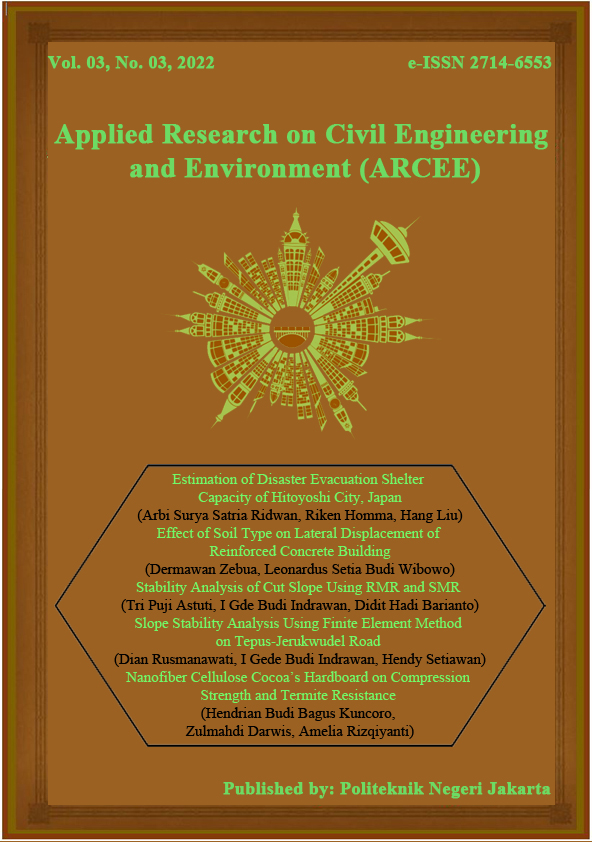Estimation of Disaster Evacuation Shelter Capacity of Hitoyoshi City, Japan
##plugins.themes.academic_pro.article.main##
Abstract
Heavy rains since early July 2020 have caused flooding in the Kyushu area. The Kuma River overflowed due to heavy rain. The river itself located in Kumamoto Prefecture right in the Hitoyoshi city. Disaster shelter is one of the most important requirements for those evacuated in the event of a disaster. It is used to analyze the supply and demand of the shelter based on the distance from the point of application to the disaster evacuation shelter, using the P-median model. As a result, the demand for evacuation shelters in the city of Hitoyoshi is 48%, which indicates that the demand for evacuation centers in case of disaster is about half. In this study, the location-allocation method was used in ArcGis 10.6 to determine the supply-demand ratio for Hitoyoshi. These data are expected to be used to optimize the operation of shelters in the Hitoyoshi area, an area prone to disasters for future urban development. This allows evacuation or disaster safety planners to develop tools for their area during floods and provides a way to predict when an event will occur and when roads will become unsafe for the residents during the future evacuation process. When a natural disaster happens again in the future, the demand and supply of disaster evacuation shelters should be assessed to determine their total capacity.
##plugins.themes.academic_pro.article.details##

This work is licensed under a Creative Commons Attribution-ShareAlike 4.0 International License.
References
- Altundal, A. S., Akın, Ö., & Demirel, H. (2022). Gis-Based Accessibility Analysis for Emergency Evacuation Meeting Areas. January. https://doi.org/10.15659/isag2021.12553
- Ameen A, A. A., Muhammed Ameen, K. M., Manchakkal, M., & Ann Johnson Assistant professor, A. (2019). Flood Mapping and Impact Analysis using GIS. International Journal of Engineering Research & Technology , 8(05), 904–906. www.ijert.org
- Chavez, E. P., Hernandez, A. A., Niguidula, J. D., & Caballero, J. M. (2017). Location Based Evacuation Center Finder. April 2018. https://doi.org/10.17758/uruae.dir0117001
- Das, S., Shaw, R., Kanbara, S., Abe, M., & Komino, T. (2020). DISASTER DURING A PANDEMIC.
- Edirisinghe, E. A. K. R., Pussella, P. G. R. N. I., & Vidarshana, W. D. M. (2021). GIS based Approach for Planning the Evacuation Process During Flash Floods: Case Study for Gampaha Divisional Secretariat Division, Sri Lanka. Journal of Geospatial Surveying, 1(1), 32. https://doi.org/10.4038/jgs.v1i1.27
- Fan, J., & Huang, G. (2020). Evaluation of flood risk management in Japan through a recent case. Sustainability (Switzerland), 12(13). https://doi.org/10.3390/su12135357
- FDMA. (2015). Fire and Disaster Management Agency. https://www.fdma.go.jp/en/post1.html
- Highfield, W. E., Peacock, W. G., & Van Zandt, S. (2014). Mitigation Planning: Why Hazard Exposure, Structural Vulnerability, and Social Vulnerability Matter. Journal of Planning Education and Research, 34(3), 287–300. https://doi.org/10.1177/0739456X14531828
- Hudson, P. (2014). Evaluating the effectiveness of flood damage mitigation measures by the application of Propensity Score Matching. Natural Hazards and Earth System Sciences Discussions, 2(1), 681–723. https://doi.org/10.5194/nhessd-2-681-2014
- Ichinose, T. (2017). Resilience and Sustainability of Rural Areas. In Proceedings of 2017 Japan-Korea Rural Planning Seminar.
- Jiang, M., Xue, X., Zhang, L., Chen, Y., Zhao, C., Song, H., & Wang, N. (2022). Peanut Drought Risk Zoning in Shandong Province , China.
- Katiyar, V., Tamkuan, N., & Nagai, M. (2020). Flood Area Detection Using Sar Images With Deep Neural. The 41st Asian Conference of Remote Sensing, 1. https://a-a-r-s.org/proceeding/ACRS2020/yohuwg.pdf
- Kenea. (2017). GIS Based Flood Hazard and Risk Assessment: A Case of Sibu Sire Woreda, Oromia Region, Ethiopia. 7(5), 307–317. http://etd.astu.edu.et/handle/123456789/697
- Li, H., & Huang, X. (2021). Fire Emergency Evacuation for Large-Scale Public Buildings in 3d Gis. IOP Conference Series: Earth and Environmental Science, 772(1). https://doi.org/10.1088/1755-1315/772/1/012003
- Liu, H., & Homma, R. (2021). Allocating Evacuation Shelters in Kumamoto Compact City under the Population Estimation. American Journal of Civil Engineering and Architecture, 9(2), 64–72. https://doi.org/10.12691/ajcea-9-2-4
- Liu, H., Homma, R., & Iki, K. (2020). Case Study of the 2016 Kumamoto Earthquake: The Disaster Response Capability of Kumamoto Compact City, Japan. MATEC Web of Conferences, 331(December), 01002. https://doi.org/10.1051/matecconf/202033101002
- Mathur, D. K. (2017). Application of GIS and RS for Flood Evacuation Planning: Olpad Taluka (Surat) Case Study. IOSR Journal of Applied Physics, 09(03), 57–61. https://doi.org/10.9790/4861-0903025761
- Morita, K., Okitasari, M., & Masuda, H. (2020). Analysis of national and local governance systems to achieve the sustainable development goals: case studies of Japan and Indonesia. Sustainability Science, 15(1), 179–202. https://doi.org/10.1007/s11625-019-00739-z
- Nakamura, I., & Llasat, M. C. (2017). Policy and systems of flood risk management: a comparative study between Japan and Spain. Natural Hazards, 87(2), 919–943. https://doi.org/10.1007/s11069-017-2802-x
- Prefecture, K., Shakti, P. C., Hirano, K., Iizuka, S., & Misumi, R. (2021). Quick Exposure Assessment of Flood Inundation : A Case Study of Hitoyoshi Quick Exposure Assessment of Flood Inundation : A Case Study of Hitoyoshi City in Kumamoto Prefecture , Japan. December 2020. https://doi.org/10.24732/NIED.00002409
- Rahman, M., Chen, N., Islam, M. M., Dewan, A., Pourghasemi, H. R., Washakh, R. M. A., Nepal, N., Tian, S., Faiz, H., Alam, M., & Ahmed, N. (2021). Location-allocation modeling for emergency evacuation planning with GIS and remote sensing: A case study of Northeast Bangladesh. Geoscience Frontiers, 12(3), 101095. https://doi.org/10.1016/j.gsf.2020.09.022
- Ridwan, A. S. S., Homma, R., & Liu, H. (2022). Factor Affecting and Damage Mapping of Flood Inundation in Japan: A Case Study of Hitoyoshi City, Kumamoto Prefecture, Japan. IOP Conference Series: Earth and Environmental Science, 989(1). https://doi.org/10.1088/1755-1315/989/1/012032
- Rimba, A., Setiawati, M., Sambah, A., & Miura, F. (2017). Physical Flood Vulnerability Mapping Applying Geospatial Techniques in Okazaki City, Aichi Prefecture, Japan. Urban Science, 1(1), 7. https://doi.org/10.3390/urbansci1010007
- Thanh, N. D., Zhenjiang, S., & Kenichi, S. (2017). Comparative study on going to evacuation shelters in school districts and the nearest shelter in the city -A Case Study of Kanazawa City, Japan. Disaster Advances, 10(8), 21–30.
- Yazdani, M., Mojtahedi, M., Loosemore, M., Sanderson, D., & Dixit, V. (2021). Hospital evacuation modelling: A critical literature review on current knowledge and research gaps. International Journal of Disaster Risk Reduction, 66(October). https://doi.org/10.1016/j.ijdrr.2021.102627

